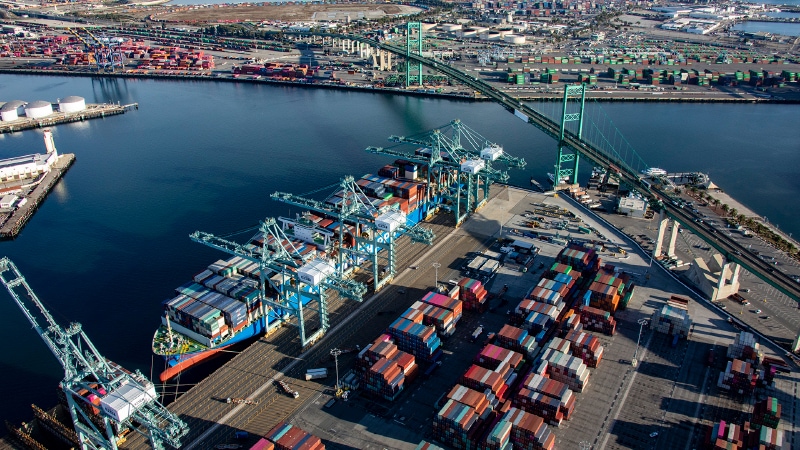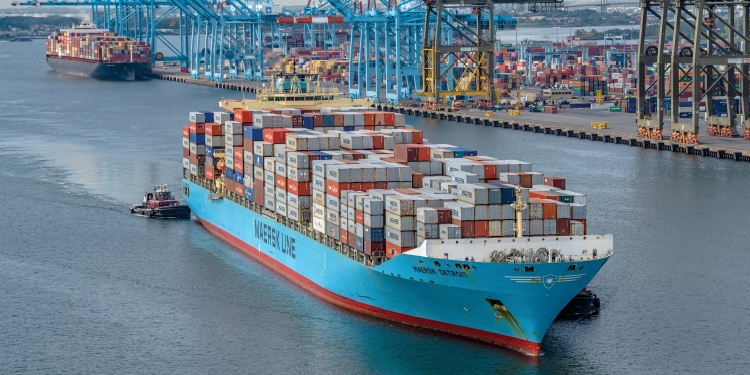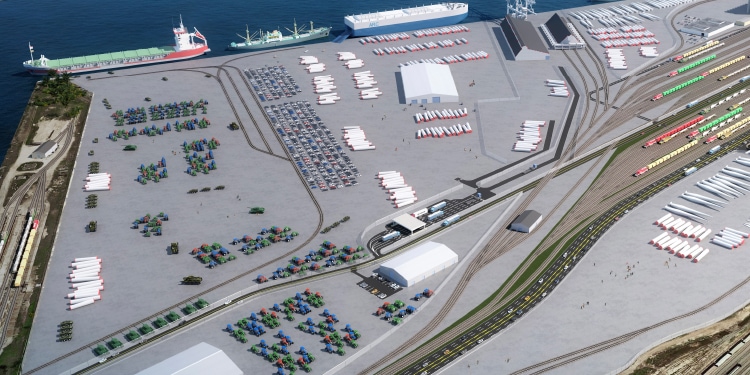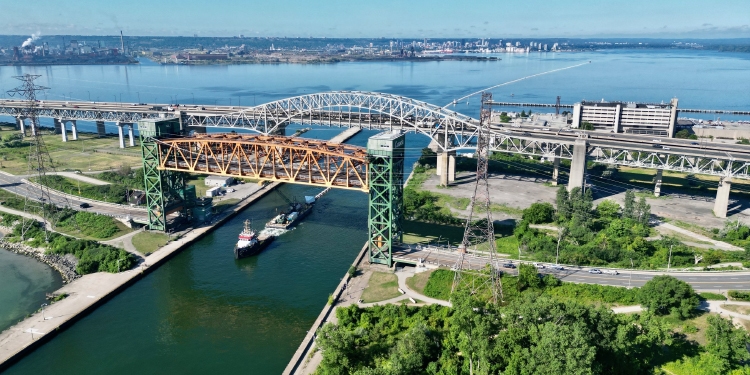Ports Update: New Strategies for a New Age

In the post-pandemic era, U.S. ports are steering new courses toward improving sustainability, collaboration, and infrastructure efforts.
When it comes to new strategies for the post-pandemic era, sustainability—long an important topic for U.S. ports—moves to the forefront.
As 2024 gets underway, leaders at U.S. ports view the concept of eco-friendly port operations as a vital element in nearly every aspect of operational decision-making. In short, sustainability is a primary focus.
“It’s definitely at the top of the list,” says Eric Caris, director of cargo marketing for the Port of Los Angeles, which is at the forefront of national and international sustainability efforts with initiatives such as the world’s first transpacific green shipping corridor connecting Southern California with Shanghai.
Other strategies for the new age in port leadership include increased collaboration among intermodal partners as well as other ports, plus ambitious infrastructure enhancements and greater use of digital tools to provide advanced visibility throughout the supply chain.
Sharing Goals
In addition to the ports’ own sustainability objectives—which are consistent with White House initiatives to achieve climate-resilient supply chain infrastructures and operations—many shippers are likewise motivated to improve sustainability in their operations. The ports, therefore, seek to partner with their customers to bolster individual sustainability efforts.
The move toward sustainability is not without challenges, however, notes Mike Bozza, assistant director of commercial development for the Port of New York and New Jersey. Specifically, it’s difficult to acquire sustainable equipment that operates with zero or low emissions.
One example is battery-operated straddle carriers, which are used for container loading and unloading. Electric straddle carriers require scheduled charges, Bozza notes, causing the equipment to be temporarily out of service, which is not ideal. The technology for sustainable equipment is steadily improving, however.
The Port of New York and New Jersey, as well as other ports, is moving resolutely toward a more sustainable future. “We are working with our terminal operators and we’ve got our own net-zero roadmap,” Bozza says.
The Port Authority’s goals include getting to net zero by 2050 as well as achieving a 50% reduction in greenhouse gas emissions for Scope 1 and Scope 2 emissions between now and 2035. (Scope 1 refers to direct emissions from sources an entity owns or controls while Scope 2 means indirect emissions from purchased electricity, steam, heat, and cooling.)
To accomplish these goals, “We’re doing things like solar installations and investing in electric vehicles for our light-duty and medium-duty fleet,” says Bozza.
The Port Authority of New York and New Jersey has also announced a “green gateway” for goods as part of the agency’s overall commitment to reducing emissions from its own operations as well as its operating partners, including marine terminal operators, oceangoing vessel operators, railroads, and trucking companies.
To date, 89 of the port’s 91 ship-to-shore and rail-mounted gantry cranes are electric, with a mandate for full electrification by 2026.
Through a marine terminal tariff, the agency is phasing out old equipment and requiring terminal operators to move to zero-emission material handling equipment as new models become commercially available.
Partnering for Progress

The Port of Los Angeles (opposite) and the Port of New York and New Jersey (above) have both embraced “green shipping corridors” for goods as a way to reduce carbon emissions.
The Port of Los Angeles continues to provide national and international leadership with its initiatives around green shipping corridors, which the U.S. State Department defines as “maritime routes that showcase low- and zero-emission lifecycle fuels and technologies with the ambition to achieve zero greenhouse gas emissions across all aspects of the corridor in support of sector-wide decarbonization no later than 2050.”
In partnership with the Port of Long Beach, the Port of Los Angeles is working with the Port of Shanghai and the C40 Cities global network of mayors to reduce greenhouse gas emissions from cargo movements. One goal is to transition to zero-carbon-fueled ships by 2030.
Collaboration with shipping lines is essential to the success of these initiatives. “Without shipping line participation, you have no green shipping corridor,” says Caris, adding that the fuels of the future must be made available in sufficient quantities to meet the needs of shipping lines.
In December 2023, the ports of Los Angeles and Long Beach also unveiled a partnership strategy with the Maritime Port Authority of Singapore to establish a green and digital shipping corridor between Singapore and the San Pedro Bay port complex in Southern California.
Collaboration was a central theme of the announcement, made at the United Nations Climate Conference in Dubai. “Our success requires the resolve and dedication of the three partnering ports as well as our industry partners,” said Gene Seroka, executive director of the Port of Los Angeles. “Together, we will model the collaboration necessary to achieve our climate and efficiency goals.”
Port of Long Beach CEO Mario Cordero echoed Serkoka’s comments. “Over the past two decades, we’ve learned that collaboration between maritime industry partners is the key to making meaningful progress in reducing emissions and cleaning the air,” Cordero said. “This transpacific green shipping corridor takes this concept global.
“The strategies we develop here can be used as a roadmap by a larger network of seaports and supply chain companies to invest in programs, technologies, software, and infrastructure to decarbonize international trade everywhere,” he added.
In his annual State of the Port address to stakeholders in January 2024, Seroka reiterated the LA port’s commitment to sustainability and the environment, bolstered by the fall 2023 announcement of up to $300 million in federal grant funding for the development of “hydrogen hub” operations in the San Pedro Bay port complex.
Stronger Infrastructure

Top-priority infrastructure developments at the Georgia Ports Authority include the newly opened Mason Mega Rail, the largest marine terminal rail facility in North America.
Across all political lines, port infrastructure has also been a perennial theme of discussion among state and federal government leaders—and those discussions are expected to intensify in the 2024 presidential election year. National and state infrastructure priorities include waterway projects designed to strengthen supply chains, speed the movement of goods, and reduce costs.
U.S. ports are leading the way in these efforts, exemplified by initiatives at the Port of Galveston, Texas, where years of groundwork are expected to reap progress with developments including major cargo infrastructure improvements and free-trade zone expansion.
Located on the deep-water Galveston Harbor and ranked as one of the Top 50 U.S. Water Ports by the U.S. Department of Transportation, the Port of Galveston is a major cargo hub that also boasts three cruise terminals.
Guided by its 20-Year Strategic Master Plan, the port is maximizing its assets for aggressive growth.
“A major focus of the master plan is expanding our cargo business by increasing acreage and improving infrastructure at our West Port Cargo Complex,” says Rodger Rees, the port’s director and CEO. “A top priority is improving decaying waterfront infrastructure after decades of neglect.
“We’re also nearing completion of a two-mile-long interior roadway to move cruise and cargo traffic more efficiently, while helping to alleviate congestion on nearby downtown roadways,” he adds.
Infrastructure is also a top priority for the Georgia Ports Authority (GPA), which represents a network of both coastal and inland ports. Included among the GPA’s ports is the Port of Savannah, the single largest and fastest-growing container facility in America.
“The infrastructure development at our Garden City Terminal West facility and the upgrade and expansion of Ocean Terminal as a container facility will be exciting developments to watch,” says Ed McCarthy, GPA’s chief operating officer.
Another central theme commanding the attention of port leaders in 2024 can be expressed in a single word: linkage.
One example is the Council of Port Performance at the Port of New York and New Jersey. The council is a group of critical stakeholders including the Port Authority, the Shipping Association of New York and New Jersey, marine terminal operators, and labor.
“This group was formed about 10 years ago to deal with congestion challenges at that time, and it has been a critical element of our success at the port,” Bozza explains.
Creating Key Linkages

The Port of Galveston, Texas, is expanding its cargo business by increasing acreage and improving infrastructure, including a new interior roadway, at its West Port Cargo Complex. The road will help to move cargo traffic more efficiently and alleviate congestion.
“We learned from our challenges during the pandemic that you have to look at the entire supply chain,” he adds. “The council and our port efficiency team are trying to create linkages from the ship all the way out to the warehouse—and every point in between—so we understand all the individual nodes.
“By doing that, when the next cargo surge comes, we will understand where those bottlenecks are and hopefully work to address them quickly,” Bozza adds.
Data transparency has helped the port augment existing relationships with trucking and rail partners with links to warehouse and distribution facilities via a weekly dashboard developed with input from all elements of the stakeholder community.
Strengthened relationships at U.S. ports also extend beyond direct business partnerships. For example, the Port of Los Angeles regularly exchanges information and insights with ports around the globe. Among other benefits, Caris says, the ports have learned from one another about ways to improve their “shore power” infrastructure. This strategy helps them reduce emissions by enabling vessels to turn off their engines and plug into the local electricity grid to power auxiliary systems while at berth.
This new age of port leadership and the increased emphasis on sustainability and other forward-thinking priorities at ports across the country benefits not only supply chain stakeholders, but the U.S. economy and businesses as well.
Spending Billions to Boost Shipping on Great Lakes, St. Lawrence Seaway

Initiatives to address the needs of the next generation in maritime shipping extend from the coasts to the vital U.S. inland port network. Especially noteworthy are investments in the St. Lawrence Seaway, which enables oceangoing vessels to travel to and from the Atlantic Ocean and to reach ports in all five of the Great Lakes via the Great Lakes Waterway.
From 2018 to 2027, $8.4 billion will have been spent to enhance marine shipping on the Great Lakes and St. Lawrence Seaway, estimates an independent survey of public and private investment firms. The survey was developed as part of a project that was requested by a public/private sector committee of American and Canadian maritime organizations.
Prepared by economic and transportation consulting firm Martin Associates, the survey quantifies ongoing investments in the navigation system to help support long-term planning and economic development goals, while also building confidence in the system’s future viability.
The survey shows that as the world undergoes a shift toward more sustainable practices, the marine shipping industry and the U.S. and Canadian governments are partnering to actively invest billions to lead the transition. In addition to identifying the level of investment, the survey also reveals investment in specific aspects of the Great Lakes–St. Lawrence Seaway system.
Expressed in U.S. dollars, this includes investments of:
- $636 million in vessel enhancements between 2018 and 2022, with at least another $328 million planned by 2027.
- $2.1 billion to enhance port and terminal infrastructure between 2018 and 2022, with at least another $1.1 billion planned by 2027.
- $3 billion for waterway infrastructure such as locks, breakwater structures, and navigation channels between 2018 and 2022, with at least another $1.2 billion planned by 2027.
The size of these expenditures illustrates broad recognition that economic growth and greenhouse gas reduction ambitions can be achieved through significant investment in maritime shipping, say port leaders.
“The survey’s conclusion is clear,” said U.S. Transportation Secretary Pete Buttigieg. “Both the public and private sectors recognize maritime commerce on the Great Lakes and St. Lawrence Seaway remain essential to the economies of the United States and Canada, and both the public and private sectors are investing to protect this irreplaceable system.
“Through President Biden’s infrastructure law, we are investing in marine shipping, which will continue to support high-quality jobs, strengthen America’s supply chains, and drive sustainable economic growth.”
